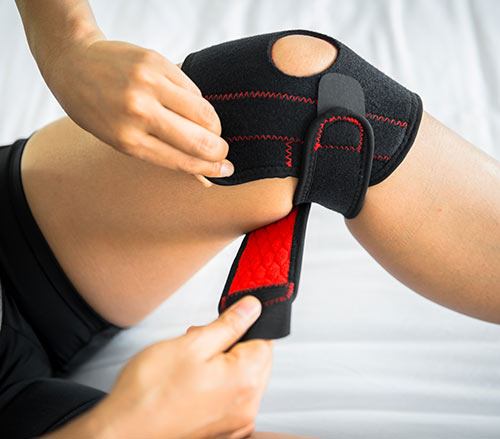A Guide to Skiing Smarter, Not Harder
Ah, the crisp mountain air, the thrill of carving through freshly fallen snow… then your knee twinges. Injuries happen, and for skiers, knee woes are some of the most common bumps in the road. But fret not, fellow enthusiasts! Even with a knee injury, you can still hit the slopes, albeit with a few adjustments. Here’s your guide to skiing smarter, not harder, with a knee injury:

Befriend the Brace:
First things first, consult your doctor or physiotherapist. They’ll assess your injury and recommend the best course of action, which often includes a trusty knee brace. Think of it as your superhero sidekick, providing much-needed support and stability. Choose a brace that fits snugly but comfortably, offering compression and warmth to the joint.
Warm Up Like a Pro:
A solid warm-up is crucial for anyone hitting the slopes, and even more so for those with knee injuries. Think dynamic stretches focusing on your quads, hamstrings, and glutes, along with light cardio to get the blood flowing. Don’t underestimate the power of squats and lunges (if appropriate for your injury) – they’ll activate those stabilizing muscles around your knee.
Technique Takes Centre Stage:
Proper skiing technique is paramount, especially with a compromised knee. Focus on smooth, controlled movements, avoiding sharp turns and excessive twisting. Engage your core to maintain balance and distribute weight evenly across both skis. Consider taking a refresher lesson if needed – a qualified instructor can tailor your technique to accommodate your injury.
Listen to Your Body, Always:
This is perhaps the most important tip. Your body speaks volumes, so pay attention! Stop if you feel pain, don’t push yourself beyond your limits, and take breaks when you need them. Skiing should be enjoyable, not an exercise in gritting your teeth through pain.
Terrain Matters:
Choose your runs wisely. Stick to gentle slopes with good snow cover, avoiding moguls, bumps, and icy patches. Gradual progression is key – start with easier runs and work your way up as your comfort and confidence increase.
Gear Up for Success:
The right equipment can make a world of difference. Opt for skis with softer flex, which will be more forgiving on your knees. Sharpened edges will provide better control, while cushioned boot liners offer additional comfort and support.
Post-Ski TLC:
Don’t neglect your knee after a day on the slopes. Ice the area for 15-20 minutes, elevate your leg, and consider compression stockings to reduce swelling. Gentle stretching and light exercises can help maintain mobility and prevent stiffness. If your resort has massage facilities, it may be worthwhile getting the post exercise rub down to optimise your condition for the following day. Alternatively pack that trusty foam roller!

Buddy Up:
Skiing with a friend or family member is always a good idea, especially when you have a knee injury. They can offer moral support, help you navigate the slopes, and be there if you need assistance.
Remember, skiing with a knee injury requires patience, adaptation, and a healthy dose of respect for your body. By following these tips, you can still enjoy the magic of the mountains, safely and comfortably. So, gear up, brace yourself, and conquer those slopes with grace and perseverance!
With a little preparation and a smart approach, skiing with a knee injury can be a rewarding and empowering experience. Embrace the challenge, listen to your body, and focus on the joy of gliding through the snow. Remember, the journey is just as important as the destination, so enjoy the ride!


